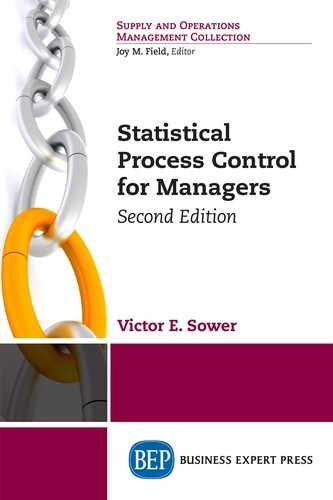Abstract
1. Balestracci (2014).
Chapter 1
1. ASQ (n.d.).
2. Stevenson (2018), p. 192.
3. A pro forma P&L is a forecast for the expected profit and loss that an organization expects to make in a specified period.
4. ASQ (n.d.).
5. Sower and Bimmerle (1991, March).
6. Walton (1986), p. 75.
7. Taguchi, Chowdhury, and Wu (2005), pp. 133–138.
8. The terms mean and standard deviation are discussed in Appendix A.
9. Sower (1990).
10. Sower (1993), pp. 41–45.
11. Sower and Fair (2012).
Chapter 2
1. For a more detailed discussion of variation see Wheeler (2000).
2. Shewhart (1931).
3. ASQ Online Quality Glossary (n.d.).
4. ASQ Online Quality Glossary (n.d.).
5. ASQ Online Quality Glossary (n.d.).
6. ASQ Online Quality Glossary (n.d.).
7. Deming (1986), pp. 327–332.
8. ASQ Online Quality Glossary (n.d.).
9. For a more complete discussion of metrology see Chapter 9 in Sower (2011); ASQ Measurement Quality Division (2004).
10. ASQ Online Quality Glossary (n.d.).
11. ASQ Online Quality Glossary (n.d.).
12. Sower (2011).
13. For a more complete discussion of gauge R&R study see Chapter 9 in Sower (2011); ASQC Automotive Division (1986).
14. Sower (2011).
15. Sower, Duffy, Kilbourne, Kohers, and Jones (2001).
Chapter 3
1. ASQ Online Quality Glossary (n.d.).
2. Standard deviation is a measure of the variation (spread) of the data around the mean. See Appendix A.
3. ASQC Statistics Division (1983), p. 30.
4. While it is most common to use 3 standard deviations for control charting, sometimes it is appropriate to use other values, for example 2 or 4 standard deviations, instead of 3. This choice depends upon a number of things the most important of which is the relative cost for missing an out of control signal versus obtaining a false signal. Further discussion of this point is beyond the scope of this book. The reader is directed to the references—particularly to Montgomery (2009), Duncan (1986), and Sower (2011).
5. Sower (2011), p. 232; Montgomery (2009), p. 198.
6. The next three chapters will provide guidance for determining what type of control chart to use for different types of data.
7. Borror, Montgomery, and Runger (1999).
8. Western Electric (1956).
Chapter 4
1. Institute for Supply Management (n.d.).
2. ASQ Online Quality Glossary (n.d.).
3. Duncan (1986); Sower (2011).
4. Evans and Lindsay (2005).
Chapter 5
1. Sower, Motwani, and Savoie (1994).
2. National Institute for Standards and Technology (n.d.).
3. Okes and Westcott (2001), p. 107.
Chapter 6
1. ASQ Online Quality Glossary (n.d.).
2. ASQ Online Quality Glossary (n.d.).
3. ASQ Online Quality Glossary (n.d.).
1. Sower and Fair (2012), pp. 4–9.
2. Sower (2011), p. 6.
3. Schmidt (2013), p. 24.
4. Guaspari (1985), p. 68.
5. Kotz and Lovelace (1998).
6. Montgomery (2009).
7. ASQ Online Quality Glossary (n.d.).
8. Taguchi, Chowdhury, and Wu (2005).
9. Roy (1990).
10. DataNet Quality Systems (n.d.).
11. EPA (n.d.).
12. The Weibull distribution is a continuous distribution related to the exponential distribution. It is most widely used to model failure rates, but can sometimes be used to model data such as that in this example.
13. Note: Even though the individual data fit a Weibull distribution, the sample means are distributed approximately normally. This is not unexpected since statistical theory says that the means of large samples drawn from a non-normal distribution will tend to be distributed normally. For this reason and because the X-bar chart has been shown to be robust to nonnormality, the choice of x-bar and s-charts is appropriate for this process.
Chapter 8
1. Stevenson (2018), pp. 165–166.
2. Parasuraman, Zeithaml, and Berry (1988).
3. Sower, Duffy, and Kohers (2008), pp. 115, 121.
4. Montgomery (2009).
Appendix A
1. Montgomery (2013).
2. Duncan (1986).
3. Sower (2011).
4. ASQ Online Quality Glossary (n.d.).
5. For more information see The Empirical Rule and Chebyshev’s Theorem at https://stats.libretexts.org/Textbook_Maps/General_Statistics/Map%3A_Introductory_Statistics_(Shafer_and_Zhang)/02%3A_Descriptive_Statistics/2.5%3A_The_Empirical_Rule_and_Chebyshev%27s_Theorem
6. Except where noted, all definitions from ASQ Online Quality Glossary (n.d.).
7. Department of Statistics (n.d.).
